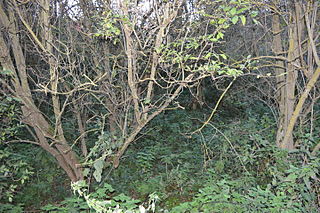External links
- Natural England website (SSSI information)
51°05′43″N2°14′03″W / 51.09517°N 2.23414°W / 51.09517; -2.23414
| | This article about a Site of Special Scientific Interest in England is a stub. You can help Wikipedia by expanding it. |
Charnage Down Chalk Pit (grid reference ST837329 ) is a 3.7 hectare geological Site of Special Scientific Interest in Wiltshire, England, lying east of the town of Mere. The former quarry site was notified in 1971 for its importance in the study of chalk rock from the late Turonian and Coniacian ages.
51°05′43″N2°14′03″W / 51.09517°N 2.23414°W
West Harnham Chalk Pit is a 2.8 hectare geological Site of Special Scientific Interest in Wiltshire, England, notified in 1971. Although named for the West Harnham area in the southwest of the city of Salisbury, the site lies in Netherhampton civil parish.

Upton Cow Down is a 16.4 hectare biological Site of Special Scientific Interest in Wiltshire. The down is an area of chalk grassland on the western edge of Salisbury Plain. It lies one mile south of the town of Westbury, above the village of Upton Scudamore.
Throope Down is a 34.4 hectare biological Site of Special Scientific Interest in Wiltshire, England, on chalk grassland in Bishopstone parish south-east of Salisbury. The site was notified in 1971 and again in 1986.

Stratford Toney Down is a 23.1 hectare biological Site of Special Scientific Interest in Wiltshire, England, which was notified in 1987. The site lies in a shallow dry valled in the south of Stratford Tony parish, about 5 miles (7.5 km) south-west of Salisbury. It is important for the botanically rich chalk grassland – mainly sheep's fescue and meadow oat-grass – which supports several nationally rare plant and butterfly species.
Burcombe Down is an area of chalk grassland situated on a north-facing scarp slope to the south of Burcombe in Wiltshire, England. Because of its species-rich plant communities, an area of 47.1 hectares of the Down has been notified as a biological Site of Special Scientific Interest, notification originally taking place in 1971.
Ebsbury Down is a 132-acre (53 ha) biological Site of Special Scientific Interest in Wiltshire, England, notified in 1975.
Great Cheverell Hill is a 33.2 hectare biological Site of Special Scientific Interest at Great Cheverell in Wiltshire, notified in 1971.
The Coombes is a 15.9 hectare biological Site of Special Scientific Interest at Hinton Parva in the Borough of Swindon, England, notified in 1989.

Cley Hill is a prominent hill to the west of Warminster in Wiltshire, England. Its summit has a commanding view of the Wiltshire / Somerset county boundary, at 244 metres (801 ft) elevation. The land is in Corsley parish and is owned by the National Trust.

Castle Lime Works Quarry is a 1.6 hectares geological Site of Special Scientific Interest near South Mimms in Hertfordshire. The site was notified in 1986 under the Wildlife and Countryside Act 1981. The site is a disused chalk quarry and according to Natural England:

Seale Chalk Pit is a 1.2-hectare (3.0-acre) geological Site of Special Scientific Interest west of Guildford in Surrey. It is a Geological Conservation Review site and part of the Seale Chalk Pit and Meadow 3-hectare (7.4-acre) private nature reserve, which is managed by the Surrey Wildlife Trust.
Erinoid Ground was a cricket ground in Stroud, Gloucestershire. The first recorded important match on the ground was in 1880, when Stroud played a United South of England Eleven.

Fayland Chalk Bank is a 0.6-hectare (1.5-acre) Site of Special Scientific Interest in Parmoor, south of Lane End in Buckinghamshire. It is in the Chilterns Area of Outstanding Natural Beauty.

Wormsley Chalk Banks are six separate areas which together are a 14.1-hectare (35-acre) biological Site of Special Scientific Interest near Turville in Buckinghamshire and Oxfordshire. The site is in the Chilterns Area of Outstanding Natural Beauty.

Chinnor Chalk Pit is a 20.4-hectare (50-acre) geological Site of Special Scientific Interest south of Chinnor in Oxfordshire. It is a Geological Conservation Review site.

Watlington and Pyrton Hills is a 112.7-hectare (278-acre) biological Site of Special Scientific Interest east of Watlington in Oxfordshire. An area of 1.6 hectares is Watlington Chalk Pit, which is a Local Nature Reserve.

Rushmore and Conholt Downs is a 111.5-hectare (276-acre) biological Site of Special Scientific Interest north of Andover in Hampshire. It is a Nature Conservation Review site, Grade I.

Stockbridge Down is a 69.8-hectare (172-acre) biological Site of Special Scientific Interest east of Stockbridge in Hampshire. It is a Nature Conservation Review site, Grade 2. It is owned by the National Trust and part of it is a Scheduled Monument, with an Iron Age hillfort and fourteen Bronze Age burial mounds.

Warren Bank is a 3.1-hectare (7.7-acre) biological Site of Special Scientific Interest south-east of Wallingford in Oxfordshire. It is managed by the Berkshire, Buckinghamshire and Oxfordshire Wildlife Trust.